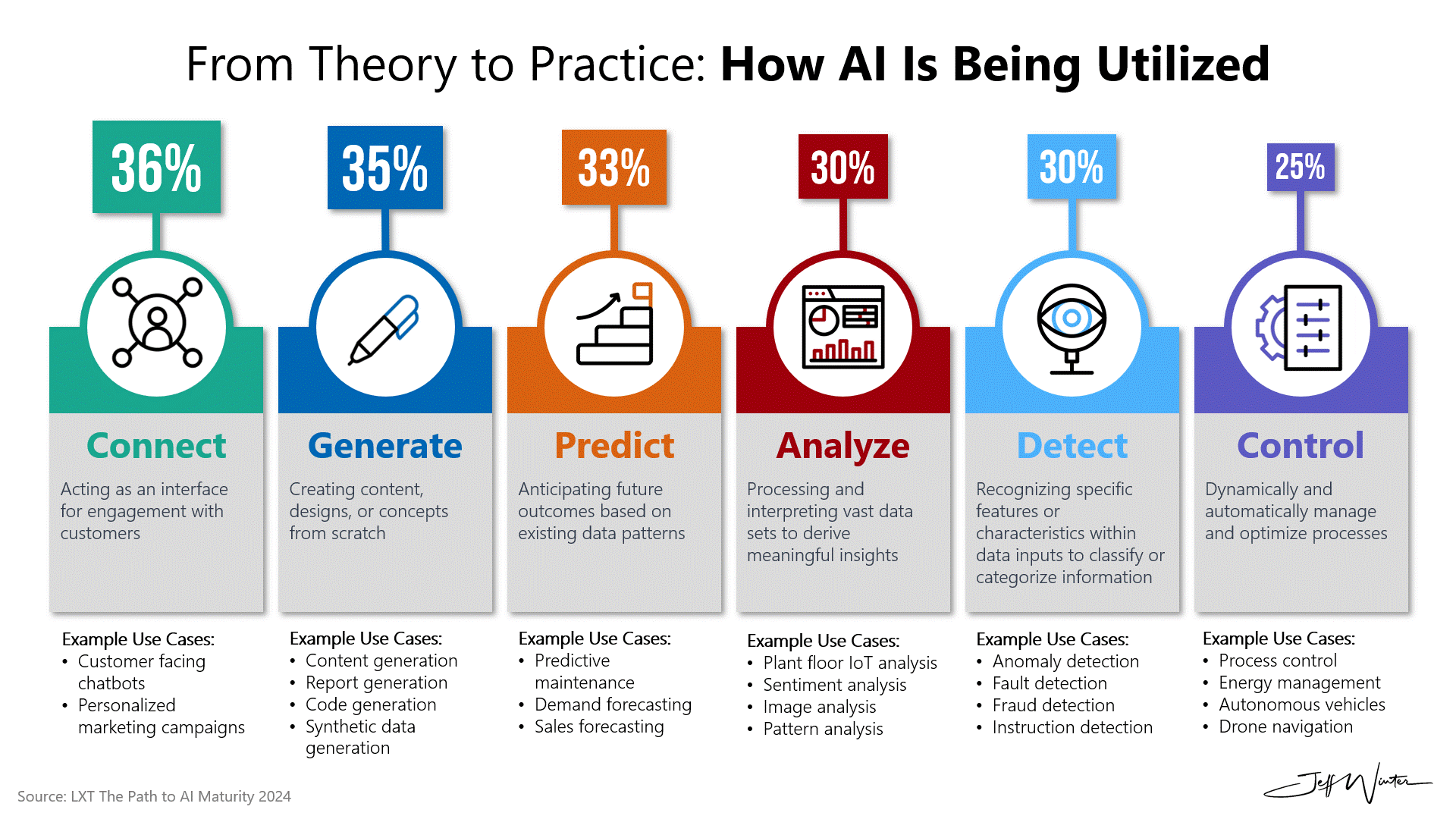From Theory to Practice: How AI Is Being Utilized
AI is driving incredible changes across industries, tackling both mundane tasks and complex challenges. One of the most exciting things about this journey is that LXT used one of my LinkedIn posts to help shape a new survey question for their Path to AI Maturity Report. Now, let's dive deeper into the six main ways AI is revolutionizing our world, especially in manufacturing.
Six Primary Uses of AI
Connect: AI is transforming how organizations engage with their customers by acting as a sophisticated interface that goes beyond simple automation. It facilitates personalized, efficient, and scalable interactions, understanding and predicting customer needs to foster deeper engagement. For example, in manufacturing, AI-powered chatbots and virtual assistants are increasingly being used to manage customer inquiries, provide instant support, and offer tailored product recommendations. These AI-driven interactions help to build stronger customer relationships and enhance overall satisfaction by providing quick and accurate responses to customer queries.
Generate: The generative capabilities of AI are redefining creativity and innovation across industries. AI can create new content, designs, or concepts from scratch, inspiring innovation and enabling creators to push the boundaries of what’s possible. In manufacturing, AI is being used to generate optimized product designs that meet specific criteria such as material efficiency, durability, and performance. AI can also assist in creating custom solutions for niche markets, automating the design process, and even generating or debugging code for manufacturing software. By leveraging AI's creative potential, manufacturers can accelerate product development cycles, reduce time-to-market, and improve product quality.
Predict: AI’s ability to predict future outcomes based on existing data patterns is transforming decision-making processes. By analyzing historical data and identifying trends, AI can forecast everything from market movements to equipment failures. This predictive power allows businesses to implement proactive strategies rather than simply reacting to changes as they occur. In manufacturing, predictive maintenance is a key application where AI analyzes operational data to predict when machinery is likely to fail, enabling maintenance to be scheduled before a breakdown occurs. This reduces unplanned downtime, extends the life of equipment, and saves costs. Additionally, AI-driven demand forecasting helps manufacturers align production schedules with market needs, minimizing waste and ensuring that resources are used efficiently.
Analyze: The vast amounts of data generated in today’s digital world can be overwhelming, but AI excels at processing and interpreting this data to extract valuable insights. AI’s analytical capabilities allow it to sift through large datasets, identify patterns, correlations, and anomalies, and provide actionable intelligence that informs critical decisions. In manufacturing, AI is used to analyze IoT data from connected devices on the factory floor, optimizing production processes and improving overall efficiency. It also plays a vital role in supply chain risk management by analyzing data to identify potential disruptions, enabling manufacturers to take preventive measures and ensure smooth operations. By turning data into insights, AI helps manufacturers make more informed decisions and stay competitive in a rapidly changing environment.
Detect: AI’s detection capabilities extend beyond simple observation, allowing it to identify and classify subtle features within data that might otherwise go unnoticed. This is particularly valuable in areas where precision and accuracy are critical. In manufacturing, AI-driven detection systems are used to identify defects in products as they are being produced. For instance, AI-powered cameras on production lines can detect imperfections in materials or inconsistencies in product dimensions, allowing for immediate corrective action. This not only improves product quality but also reduces waste by catching defects early in the production process. AI is also used in quality control to monitor production processes and ensure that they meet established standards, helping manufacturers maintain a high level of consistency and reliability.
Control: While many AI applications focus on augmenting human decision-making, AI’s control capabilities allow it to take the reins entirely in certain situations. Unlike traditional control systems that rely on pre-programmed rules, AI-driven control systems can adapt to new scenarios without needing explicit instructions. This makes AI particularly useful in dynamic environments where conditions are constantly changing. In manufacturing, AI is used to control various processes such as energy management, where it optimizes energy consumption across a factory by adjusting equipment operation based on real-time demand. AI also plays a key role in automated quality control, using cameras and sensors to monitor production lines and make real-time adjustments to maintain product quality. By taking direct control of critical processes, AI helps manufacturers achieve greater efficiency, reduce costs, and enhance overall productivity.
Harnessing these six capabilities of AI is not just about automating existing processes; it’s about opening the door to a new era of innovation, intelligence, and integration. As we continue to explore and expand the potential of AI, the possibilities for its application in manufacturing—and beyond—are truly limitless.
References:
LXT - Path to AI Maturity 2024 Report: https://info.lxt.ai/the-path-to-ai-maturity-2024
Tune in to this episode to learn more about Jeff’s take on LXT’s recently published Path to AI Maturity report, the current state of the AI evolution, and how companies can begin or further their AI and digital transformation.


